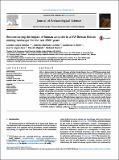Por favor, use este identificador para citar o enlazar a este item:
http://hdl.handle.net/10261/223936COMPARTIR / EXPORTAR:
 SHARE
BASE SHARE
BASE
|
|
| Visualizar otros formatos: MARC | Dublin Core | RDF | ORE | MODS | METS | DIDL | DATACITE | |

| Campo DC | Valor | Lengua/Idioma |
|---|---|---|
| dc.contributor.author | López Merino, Lourdes | es_ES |
| dc.contributor.author | Martínez Cortizas, Antonio | es_ES |
| dc.contributor.author | Reher Díez, Guillermo | es_ES |
| dc.contributor.author | López Sáez, José Antonio | es_ES |
| dc.contributor.author | Mighall, Tim M. | es_ES |
| dc.contributor.author | Bindler, Richard | es_ES |
| dc.date.accessioned | 2020-11-27T14:26:55Z | - |
| dc.date.available | 2020-11-27T14:26:55Z | - |
| dc.date.issued | 2014 | - |
| dc.identifier.citation | Journal of Archaeological Science 50, 2014, 208-218 | es_ES |
| dc.identifier.issn | 0305-4403 | - |
| dc.identifier.uri | http://hdl.handle.net/10261/223936 | - |
| dc.description.abstract | Little is known about the impact of human activities during Roman times on NW Iberian mining landscapes beyond the geomorphological transformations brought about by the use of hydraulic power for gold extraction. We present the high-resolution pollen record of La Molina mire, located in an area intensely used for gold mining (Asturias, NW Spain), combined with other proxy data from the same peat core to identify different human activities, evaluate the strategies followed for the management of the resources and describe the landscape response to human disturbances. We reconstructed the timing and synchronicity of landscape changes of varying intensity and form occurred before, during and after Roman times. An open landscape was prevalent during the local Late Iron Age, a period of relatively environmental stability. During the Early Roman Empire more significant vegetation shifts took place, reflected by changes in both forest (Corylus and Quercus) and heathland cover, as mining/metallurgy peaked and grazing and cultivation increased. In the Late Roman Empire, the influence of mining/metallurgy on landscape change started to disappear. This decoupling was further consolidated in the Germanic period (i.e., Visigothic and Sueve domination of the region), with a sharp decrease in mining/metallurgy but continued grazing. Although human impact was intense in some periods, mostly during the Early Roman Empire, forest regeneration occurred afterwards: clearances were local and short-lived. However, the Roman mining landscape turned into an agrarian one at the onset of the Middle Ages, characterized by a profound deforestation at a regional level due to a myriad of human activities that resulted in an irreversible openness of the landscape. | es_ES |
| dc.description.sponsorship | This work was funded by the projects HAR2008-06477-C03-03/HIST, CGL2010-20672 (Plan Nacional I+D+i, Spanish Ministry of Science and Innovation), 10PXIB200182PR (General Directorate of I+D, Xunta de Galicia), and CDS-TCP (CSD2007-00058, Programa Consolider-Ingenio 2010) | es_ES |
| dc.language.iso | eng | es_ES |
| dc.publisher | Elsevier | es_ES |
| dc.relation | info:eu-repo/grantAgreement/MINECO/Plan Estatal de Investigación Científica y Técnica y de Innovación 2013-2016/HAR2008-06477-C03-03/HIST | es_ES |
| dc.relation | info:eu-repo/grantAgreement/MINECO/Plan Estatal de Investigación Científica y Técnica y de Innovación 2013-2016/CGL2010-20672 | es_ES |
| dc.relation.isversionof | Publisher's version | es_ES |
| dc.rights | openAccess | es_ES |
| dc.subject | Pollen analysis | es_ES |
| dc.subject | Forest clearance | es_ES |
| dc.subject | Mining/metallurgy | es_ES |
| dc.subject | Human impact | es_ES |
| dc.subject | Forest resilience | es_ES |
| dc.title | Reconstructing the impact of human activities in a NW Iberian Roman mining landscape for the last 2500 years | es_ES |
| dc.type | artículo | es_ES |
| dc.description.peerreviewed | Peer reviewed | es_ES |
| dc.relation.publisherversion | https://doi.org/10.1016/j.jas.2014.07.016 | es_ES |
| dc.rights.license | http://creativecommons.org/licenses/by-nc-nd/3.0/ | es_ES |
| dc.contributor.funder | Ministerio de Ciencia e Innovación (España) | es_ES |
| dc.contributor.funder | Xunta de Galicia | es_ES |
| dc.relation.csic | Sí | es_ES |
| oprm.item.hasRevision | no ko 0 false | * |
| dc.identifier.funder | http://dx.doi.org/10.13039/501100004837 | es_ES |
| dc.identifier.funder | http://dx.doi.org/10.13039/501100010801 | es_ES |
| dc.contributor.orcid | López Sáez, José Antonio [0000-0002-3122-2744] | es_ES |
| dc.contributor.orcid | Reher Díez, Guillermo [0000-0002-5870-9288] | - |
| dc.contributor.orcid | López Merino, Lourdes [0000-0002-6361-5374] | - |
| dc.contributor.orcid | Martínez Cortizas, Antonio [0000-0003-0430-5760] | - |
| dc.contributor.orcid | Bindler, Richard [0000-0002-7900-309X] | - |
| dc.type.coar | http://purl.org/coar/resource_type/c_6501 | es_ES |
| item.openairetype | artículo | - |
| item.languageiso639-1 | en | - |
| item.cerifentitytype | Publications | - |
| item.grantfulltext | open | - |
| item.fulltext | With Fulltext | - |
| item.openairecristype | http://purl.org/coar/resource_type/c_18cf | - |
| Aparece en las colecciones: | (CCHS-IH) Artículos | |
Ficheros en este ítem:
| Fichero | Descripción | Tamaño | Formato | |
|---|---|---|---|---|
| Reconstructing the impact_2014.pdf | 4,69 MB | Adobe PDF |  Visualizar/Abrir |
CORE Recommender
Page view(s)
132
checked on 22-may-2024
Download(s)
108
checked on 22-may-2024
Google ScholarTM
Check
Este item está licenciado bajo una Licencia Creative Commons

